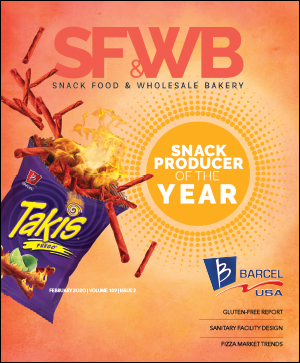Move It or Lose It
Move It or Lose It
With rising overheads applying pressure to the bottom line, bakers and snack producers are relying on increasingly durable belting and conveyors to maximize the efficiency of their operations.
Lean and mean: That’s the new mantra for the snack food and wholesale baking industry.
“Now, more than ever, there is increased pressure on maximizing corporate profits,” notes Joe Lackner, vice president of marketing and sales for Ashworth Bros. Inc. “This means that bakers must maximize production efficiencies, which translates into minimizing downtime. Coupled with this is the need to conserve company resources, particularly labor and energy. At the same time, there is increased pressure from the general public and governmental agencies to guarantee increasingly higher standards of food safety.”
Most bakers and snack producers, he adds, find it difficult to maximize output without jeopardizing these other considerations.
“They are not creating profits when the facility is shut down for cleaning and sanitation or, for that matter, repairing conveyor belts,” Lackner adds. “So the challenge is finding ways to maximize production while minimizing downtown and increasing food safety.”
Lean and clean could be another mantra for the industry. That’s because belts and conveyors now must offer greater sanitation, less noise, quick changeovers and greater versatility, adds Eric Doern, product line manager for PPM Technologies.
“The industry is continually improving the overall sanitation of their products as well as applying practices that reduce the overall sanitation time,” Doern explains. “Processors are also challenged with improving overall process efficiencies. This can mean many things for processors, from looking at ways to intelligently control product flow to finding solutions that will maintain product quality throughout the process.”
Bakers also are increasingly concerned about food safety and security, especially in the area of allergens and pathogens, says Rick Spiak, vice president of sales for Wire Belt Co. of America.
“Ease of sanitation is a major focus demanded by many bakers,” Spiak says. “The idea of constantly removing a belt to soak it in a C.O.P. (clean out of place) tank is costly, time consuming and not energy efficient. Most snack food and bakery producers want a belt that has few places for allergens to hide and can be easily leased with equipment they already own.”
Wire Belt’s new Compact Grid offers bakers the convenience of clean-in-place sanitation with a 70% open area. It allows for easy cleaning and maximum flow through what Spiak describes as superior convection. There are no woven wire helixes where allergens can lurk. The system can be retrofitted easily in existing operations, he adds.
When it comes to sanitation, it’s not only about allergens. Terry Benda, president of Benda Manufacturing, notes that cross-contamination can be a big issue with organic snacks and baked goods. Those products need to be run on lines that have been recently cleaned or are at the beginning of a shift and contain no residue from production of conventional items.
With some all-natural products, he adds, mold can be a problem. Prime suspects are ambient air coolers and conveyors where mold spores can grow and contaminate products prior to packaging. Vinegar is a natural mold inhibitor, but only so much can be used in baked goods. As a result, these bakers need specific types of conveyors that are easy to keep clean.
Clean and Safe
Ashworth recently introduced its Advantage line of hybrid spiral/turn-curve belts, which are manufactured with stainless steel rods and Acetal plastic surface modules. The belts feature a hygienic design that is easy to clean, and it’s the only spiral belt to be certified by the National Sanitation Foundation (NSF), accepted by the U.S. Department of Agriculture third party-verified by BISSC.
“Less than two years ago, we would have never heard of the term USDA in our bakery industry, but sanitation is becoming increasing important,” Lackner says.
In response to food safety concerns, Forbo Siegling has introduced a line of blue belts. The high-contrast blue color allows for easier identification of foreign matter, says Rich Grantham, North American food segment manager.
The line is available in hydrolysis-resistant cover compounds that meet Hazardous Analysis Critical Control Point (HACCP) sanitation criteria and can come with encapsulated or sealed edges. The belts have dimensional stability, which eliminates belt stretch and edge curling often related to changes in temperature, chemicals or humidity. They also can negotiate around small diameter pulley transfers. In many cases, that means going around nose-bars as small as 3 mm.
“The only way to implement successful belting design changes is to fully understand the market, the external forces driving changes in the market and how our innovation will help the customer meet the new production demands generated by these changes,” Grantham says.
Get a Move on It
When it comes to belting and conveyors, there’s a lot more to these systems than simply moving tasty products from one part of the plant to another. With skyrocketing commodity prices and the astronomical cost of fuel, Benda says, bakers and snack producers are looking for ways to cut costs.
Because production facilities have become so automated, adding a simple conveyor can reduce labor significantly, he explains. Companies like Benda Manufacturing are supplying conveyors using sensing devices servo drives and programmable controls to stop, start, and shift and align products without the need for added employees to monitor production flow.
“We’ve done a lot to make conveyors intelligent,” Benda says.
Imbedded logic in conveying systems provides bakers and snack producers with the ability to improve process flow, Doern adds, whether through proportional product transfer to scale systems or flow control devices throughout the process line. By improving line flow, companies increase operational efficiencies.
Bakers and snack producers often rely on suppliers’ engineers and customer service specialists to select the most appropriate systems, says Nubia Westland, business development analyst — bakery team at Intralox L.L.C. Sometimes, custom-designed solutions are needed. Other times, Westland notes, matching the correct belt with the right system can extend and possibly double the life of a conveyor.
Intralox differentiates itself by providing solutions, rather than just belts, that reduce product loss, maintenance and unscheduled downtime. At last fall’s International Baking Industry Exposition, the company showcased its patented Activated Roller Belt, which featured descrambling, automatic switching, 90-degree transfers, perpetual merge and sorting without many of the guards and gates that other systems require.
To provide turnkey solutions for bakers, belting and conveying companies such as SpanTech LLC design and manufacturer components to work together to reduce wear and downtime.
“The chain is completely captured to the frame over the entire length of the conveyor,” says Sheila Steenbergen, director of sales and marketing for the company. “The catenary or take-up is eliminated, resulting in less been eliminated [and] in less wear on the chain as well as quieter and safer operations.”
SpanTech offers modular chain widths in 1-in. increments, from 1.19 in. to 48 in. and beyond. Some of its most recent improvements include optional 3.5-in. diameter low-profile conveyor ends, optional intermediate drive units and the elimination of black carbon deposits on the chain.
During the production of snacks and baked goods, steel belts often are exposed to extreme mechanical and thermal stress. Berndorf Band GmbH notes that its steel goes through a complicated heat treatment process to withstand fluctuating operating temperatures and a high number of loads. Its CARBO 13 belt can easily handle operating temperatures up to 750°F, the company says. The uniform dark, heat-absorbing surface ensures high product quality and energy efficiency.
For many bakers, maximizing their floor space is one way to improve plant efficiencies. Dorner Manufacturing Corp. notes that its 5200 Series conveyors, which allow products to make 150- to 180-degree turns. Companies such as Dorner also offer modular belting that can be repaired with a snap or two or that allows bakers to quickly install a checkweigher or X-ray machine into the line.
PPM Technologies offers a new proportional gate that uses standard gate technology applied with logic to meter product precisely to scale feeders, which allow production lines to operate more efficiently.
Additionally, PPM Technologies Libra Mass Flow System provides continuous inline weighing that provides consistent, accurate metering, weighing and blending of products within a processing line
“We will continue to focus our development efforts on how our technologies may be applied to improve the performance of a variety of processes,” Doern says. “Improving process line efficiencies automatically add value to the processor’s bottom line.”
With belts and conveyors, if you are not moving ahead, you’re not going anywhere too soon. SF&WB
Editor’s Note: For more information about companies mentioned in this article, check out our Buyer’s Guide at www.SnackAndBakery.com.
Looking for a reprint of this article?
From high-res PDFs to custom plaques, order your copy today!







